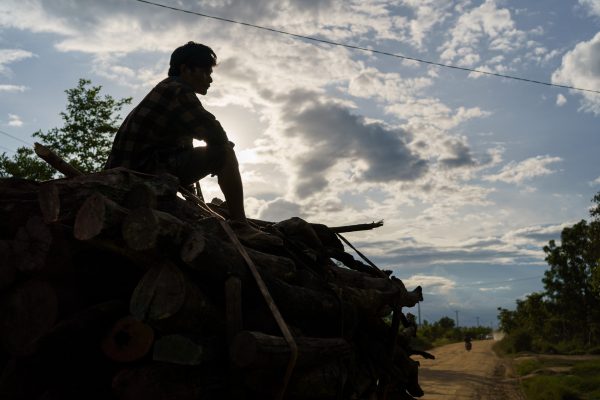New research from Cambodia challenges the microfinance industry’s assertions that its loans help farmers to resist the impacts of climate change.
In fact, the research argues, microfinance undermines the capacity of farmers to respond to unstable climate conditions. The profit from Cambodia generated by foreign-owned microfinance institutions should be taxed and the proceeds used to set up funds to address climate change impacts in Cambodia, the report says.
The report, which was published by U.K.-based academics at the universities of London, Reading, and Greenwich, draws from research conducted in three villages in the provinces of Prey Veng, Kampong Cham, and Battambang between October 2020 and February 2022. The villages are not identified to protect the anonymity of respondents.
If taxation sounds like a recipe for slowing down the industry’s growth, then that is exactly the intention. Cambodia has one of the world’s highest rates of microfinance debt, with average per capita debt of $4,213 at the end of 2021, more than double the country’s per capita GDP. The market is “vastly over-saturated,” says Vincent Guermond, one of the report’s authors.
Time works not for but against the typical Cambodian microfinance borrower. The loans are “difficult if not impossible to repay in the long term,” the report says, so indebtedness persists and deepens over time. The report found that 12.5 percent of respondents had borrowed from a microfinance institution partly to repay another loan, while 5 percent of indebted households had sold agricultural land to repay loans in the last 10 years. Though some borrowers might get a temporary benefit from being able to borrow, “these loans tend to do more harm than good,” Guermond says.
Microfinance over the last five to ten years has pushed the claim that farmers become more resilient to climate shocks, packaged under labels such as “climate adaptation finance.” Cambodia is one of the world’s most vulnerable countries to climate change, and rice farmers are especially vulnerable due to dependence on fluctuating rainfall patterns, the report says.
The evidence is that paying back the debt simply compounds the other problems that households face, says Guermond, a specialist in microfinance who has researched the subject in West Africa. There is, he says, no robust statistical evidence from anywhere that microfinance benefits poor countries.
The “microfinance” category includes other financial products such as savings and insurance, which are less profitable than lending, but result in the customer being in credit, or insured, rather than in debt. Lending as a form of microfinance, or microcredit, was pioneered by Nobel Peace Prize winner Muhammad Yunus in Bangladesh in the 1980s. Microcredit has been transformed from a form of aid into a large-scale financial-services industry. Yunus argued that “‘every single human being, even one barefoot and begging in the street, is a potential entrepreneur.”
Yet most people in the West are not an entrepreneur and have never tried to become one. There’s no reason to think the proportion of people in poor countries with an entrepreneurial skillset is higher than elsewhere. In Cambodia, Guermond says, the stresses have been accentuated by the withdrawal of government agricultural subsidies and safety nets over the last decade. At the same time, farming in Cambodia has become more capital intensive as more machinery, chemicals, and fertilizers are needed for farmers to be competitive. In contrast to the industry’s claim that microfinance allows borrowers to expand their small businesses, Guermond says, the reality is that “people have no choice but to borrow to make ends meet.”
Cambodia has over 3 million microfinance borrowers in a population of 17 million. The role of foreign aid organizations in Cambodia’s post-Khmer Rouge reconstruction in the 1990s is one reason why the scale of lending dwarfs that in other poor countries. ACLEDA, the Association of Cambodian Local Economic Development Agencies, was established in 1993 as a non-profit organization, financed by the United Nations Development Program and the International Labor Organization. It shifted to providing microfinance on a commercial basis, and is now the country’s largest bank. Shareholders include Triodos in the Netherlands, French bank BRED, and Japan’s Sumitomo Mitsui Banking Corp.
It’s unusual for a microfinance lender to be a fully-fledged bank, let alone the largest in a country, Guermond says. International development community finance provided to microfinance lenders should be reallocated into support for credit unions, financial cooperatives, and community development banks, the report recommends. Debt forgiveness for households should be combined with the replacement of microfinance loans with unconditional cash transfers and the strengthening of social provision.
Microfinance lenders in Cambodia point to their low levels of non-performing loans (NPLs) to argue that the model is sustainable. The lenders and those who finance them should dig deeper to understand why those NPLs have been achieved, Guermond says. Low NPL levels don’t mean anything if people use “harmful coping strategies” to pay. These include selling land, cutting back on food, and sending family members to work in brick kilns or abroad in Thailand to make payments. “The industry should acknowledge the sacrifices which are made to repay,” he says.


